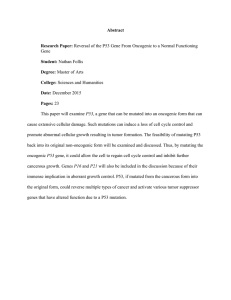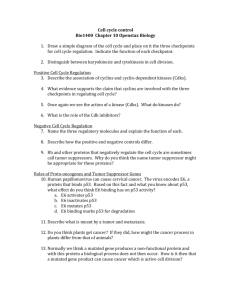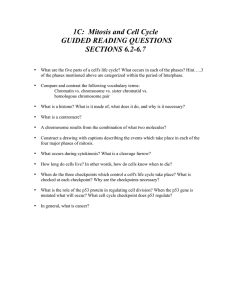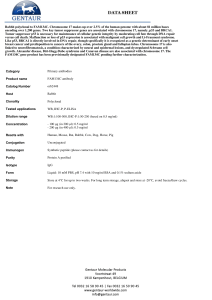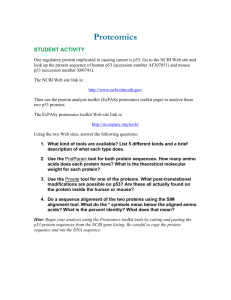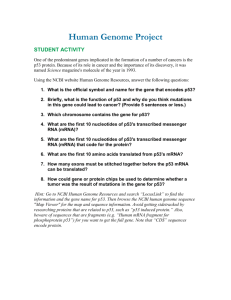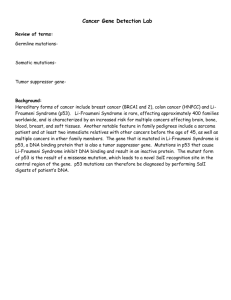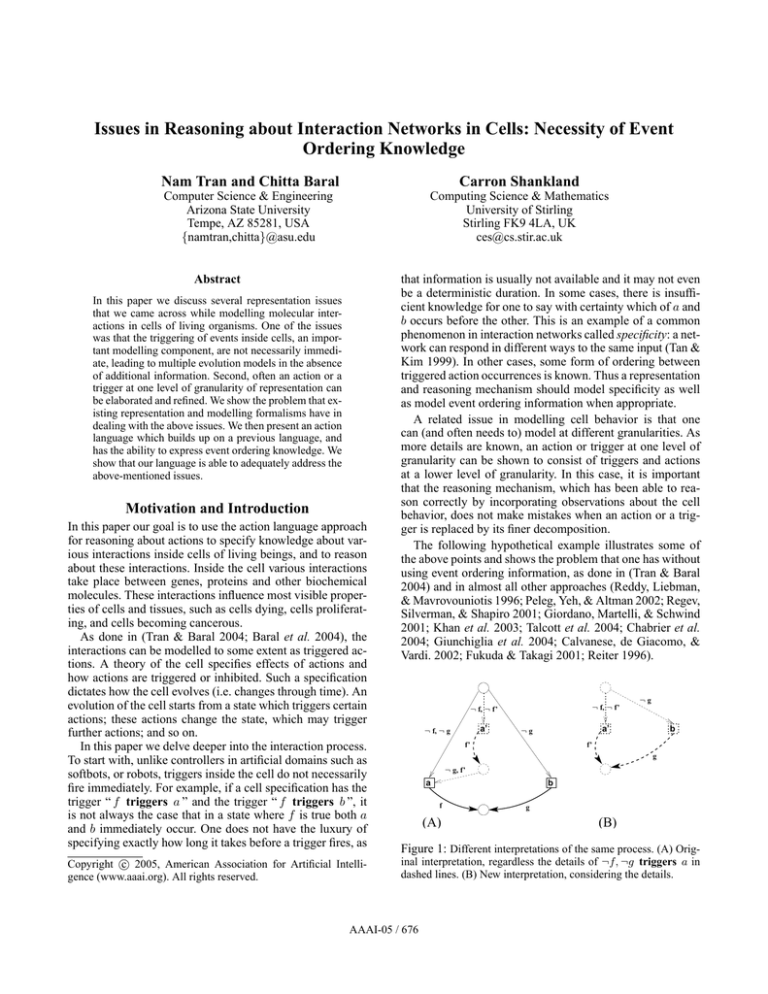
Issues in Reasoning about Interaction Networks in Cells: Necessity of Event
Ordering Knowledge
Nam Tran and Chitta Baral
Carron Shankland
Computer Science & Engineering
Arizona State University
Tempe, AZ 85281, USA
{namtran,chitta}@asu.edu
Computing Science & Mathematics
University of Stirling
Stirling FK9 4LA, UK
ces@cs.stir.ac.uk
Abstract
In this paper we discuss several representation issues
that we came across while modelling molecular interactions in cells of living organisms. One of the issues
was that the triggering of events inside cells, an important modelling component, are not necessarily immediate, leading to multiple evolution models in the absence
of additional information. Second, often an action or a
trigger at one level of granularity of representation can
be elaborated and refined. We show the problem that existing representation and modelling formalisms have in
dealing with the above issues. We then present an action
language which builds up on a previous language, and
has the ability to express event ordering knowledge. We
show that our language is able to adequately address the
above-mentioned issues.
Motivation and Introduction
In this paper our goal is to use the action language approach
for reasoning about actions to specify knowledge about various interactions inside cells of living beings, and to reason
about these interactions. Inside the cell various interactions
take place between genes, proteins and other biochemical
molecules. These interactions influence most visible properties of cells and tissues, such as cells dying, cells proliferating, and cells becoming cancerous.
As done in (Tran & Baral 2004; Baral et al. 2004), the
interactions can be modelled to some extent as triggered actions. A theory of the cell specifies effects of actions and
how actions are triggered or inhibited. Such a specification
dictates how the cell evolves (i.e. changes through time). An
evolution of the cell starts from a state which triggers certain
actions; these actions change the state, which may trigger
further actions; and so on.
In this paper we delve deeper into the interaction process.
To start with, unlike controllers in artificial domains such as
softbots, or robots, triggers inside the cell do not necessarily
fire immediately. For example, if a cell specification has the
trigger “ f triggers a ” and the trigger “ f triggers b ”, it
is not always the case that in a state where f is true both a
and b immediately occur. One does not have the luxury of
specifying exactly how long it takes before a trigger fires, as
c 2005, American Association for Artificial IntelliCopyright °
gence (www.aaai.org). All rights reserved.
that information is usually not available and it may not even
be a deterministic duration. In some cases, there is insufficient knowledge for one to say with certainty which of a and
b occurs before the other. This is an example of a common
phenomenon in interaction networks called specificity: a network can respond in different ways to the same input (Tan &
Kim 1999). In other cases, some form of ordering between
triggered action occurrences is known. Thus a representation
and reasoning mechanism should model specificity as well
as model event ordering information when appropriate.
A related issue in modelling cell behavior is that one
can (and often needs to) model at different granularities. As
more details are known, an action or trigger at one level of
granularity can be shown to consist of triggers and actions
at a lower level of granularity. In this case, it is important
that the reasoning mechanism, which has been able to reason correctly by incorporating observations about the cell
behavior, does not make mistakes when an action or a trigger is replaced by its finer decomposition.
The following hypothetical example illustrates some of
the above points and shows the problem that one has without
using event ordering information, as done in (Tran & Baral
2004) and in almost all other approaches (Reddy, Liebman,
& Mavrovouniotis 1996; Peleg, Yeh, & Altman 2002; Regev,
Silverman, & Shapiro 2001; Giordano, Martelli, & Schwind
2001; Khan et al. 2003; Talcott et al. 2004; Chabrier et al.
2004; Giunchiglia et al. 2004; Calvanese, de Giacomo, &
Vardi. 2002; Fukuda & Takagi 2001; Reiter 1996).
¬ f, ¬ f’
¬ f, ¬ f’
a’
¬ f, ¬ g
¬g
a’
¬g
b
f’
f’
g
¬ g, f’
a
b
f
(A)
g
(B)
Figure 1: Different interpretations of the same process. (A) Original interpretation, regardless the details of ¬f, ¬g triggers a in
dashed lines. (B) New interpretation, considering the details.
AAAI-05 / 676
Consider a cell specification in the language A0T (Tran &
Baral 2004) given as follows.
Daf g = {¬f, ¬g triggers a;
¬g triggers b;
a causes f ;
b causes g}
The semantics of A0T dictates that if an action is triggered at
time t then it has to occur at time t. Assume that f and g are
false at time 0, then both a and b occur at time 0. The occurrence of a makes f become true at time 1. Now imagine
that the trigger ¬f, ¬g triggers a is refined by the following
more elaborated knowledge:
¬f , ¬f 0 triggers a0
0
a causes f
(1)
0
(2)
0
f , ¬g triggers a
(3)
That is, the triggering of the action a by ¬f ∧ ¬g is mediated by some new action a0 and fluent f 0 (dashed lines in
Fig. 1A). Given the same initial condition of f and g being
false at time 0, a different conclusion about the final value of
f would be drawn from the refined interaction specification
(Fig. 1B). The argument goes as follows. If f 0 is true at time
0, then a0 (hence, a) will not be triggered; thus f remains
false. On the other hand, if f 0 is false at time 0 then the actions a0 and b occur at time 0, which results in ¬f and g at
time 1. Then no additional action can be triggered from time
1 onwards, so f is always false. Thus the new conclusion
(about f ) contradicts the previous prediction from the old
specification Daf g . Intuitively, this non-monotonicity with
respect to refinement is not acceptable. Since the detailed
knowledge represented by the statements (1)-(3) is about
what happens “inside” the trigger of a, the consequence of
the trigger itself should not be affected, provided everything
“outside” remains intact.
The above example illustrates a challenging elaboration
tolerance issue in representing interaction networks, as often
new details about various intracellular mechanisms emerge,
and the modelling and reasoning mechanism should be able
to accommodate the refinement without breaking down.
The rest of the paper is organized as follows. In the next
section we will discuss a real example of molecular interactions that motivated our work in this paper. We then propose
a language A∞
T that can gracefully address the modelling
problems posed by this real example. Finally, we present
formal results on elaboration tolerance of A∞
T , which generalizes all the special cases discussed in the paper.
Challenges in Modelling the p53 Network
We came across this example when we were modelling interactions of the p53 protein network. The example poses the
following modelling challenges: (1) elaboration of more refined knowledge that is correct with respect to reasoning; (2)
representing and reasoning about non-deterministic cellular
behaviors called specificity; and (3) incorporation of event
ordering knowledge into representing and reasoning about
interactions in cells.
First, let us review the special case of A0T language that
does not involve exogenous actions (Tran & Baral 2004).
Brief overview of A0T
The alphabet of the language A0T (without exogenous actions) consists of two nonempty disjoint sets of symbols: a
set of actions and a set of fluents. A fluent is a propositional
symbol. A fluent literal is a fluent or its negation. A set of
fluent literals is consistent if it does not contain both a fluent
and its negation. A state is an interpretation of the fluents
(i.e. a maximal consistent set of fluent literals).
A domain description D in A0T is a set of statements of
the following forms:
a causes f if f1 , . . . , fn
(4)
g1 , . . . , gm triggers b
(5)
h1 , . . . , hl inhibits c
(6)
where fi , gj , hk and f and g are fluent literals and a, b, c
are individual actions. (4) is a dynamic causal rule, which
says that f is to be true in the state succeeding a state where
a occurs and all the f1 , . . . , fn hold. (5) is a trigger rule,
which says that action b is to occur if it is not inhibited and
if all the literals g1 , . . . , gm hold. (6) is an inhibition rule,
which says that action c can not happen (i.e. is inhibited) if
all the literals h1 , . . . , hl hold.
A state transition is a change of one state to another state
due to effects of some actions. The effect of an action a in a
state s is the set E(a, s) = { f | a causes f if f1 , . . . fn ∈
D and {f1 , . . . , fn } ⊆ s }. TheSeffect of a set A of actions in
a state s is the set E(A, s) = a∈A E(a, s). Let ¬¬g = g
and ¬E(A, s) = {¬g|g ∈ E(A, s)}. A set A of actions
transforms a state s to the state Φ(A, s) defined as:
• Φ(∅, s) = s;
• if A 6= ∅ and E(A, s) is consistent, then
Φ(A, s) = (s \ ¬E(A, s)) ∪ E(A, s) ;
• otherwise Φ(A, s) is undefined.
The function Φ is also called the transition function of D.
A transition sequence τ is a sequence of the form τ =
hs0 , A0 , s1 , A1 , . . .i; where si ’s are states and Aj ’s are sets
of actions in D, such that si+1 = Φ(Ai , si ) for all i.
Throughout the rest of the paper we will use the notation that si (τ ) = si and Ai (τ ) = Ai . Moreover, if τ is
such that Ai 6= ∅, Aj = ∅ for all j > i, then we write
τ = hs0 , A0 , s1 , A1 . . . Ai , si i.
A trajectory is a transition sequence τ where Ai (τ ) is
the set of all the actions that are triggered but not inhibited in state si (τ ). Observations are statements of the form
“ f at i ” or of the form “ a occurs at j ”, where i and j
are non-negative integers. The former statement means that
the fluent literal f is observed to be true at time i. The latter means that the action a is observed to occur at time j. A
trajectory τ satisfies “ f at i ” iff f ∈ si (τ ); and τ satisfies
“ a occurs at j ” iff a ∈ Aj (τ ).
A theory is a pair (D, O) where D is a domain description
and O is a set of observations. A model of a theory (D, O) is
a trajectory of D that satisfies all the observations of O and
is minimal with respect to the following partial order ≤0 .
Definition 1. Let τ and τ 0 be trajectories where s0 (τ ) =
s0 (τ 0 ). Then τ ≤0 τ 0 iff there exists a sequence 0 ≤ i0 <
i1 < . . . < in < . . . such that for every k ≥ 0, Ak (τ ) ⊆
Aik (τ 0 ).
2
AAAI-05 / 677
We are now ready to discuss the interaction network of the
p53 protein. In the network description , “adjective” predicates denote fluent symbols and “verb” predicates denote
action symbols.
Issues in modelling the p53 network
The p53 protein is a tumor suppressor that plays a key role
in the regulation of the cell growth and cell death. It is estimated that about one half of human cancers contain mutant p53. It is also predicted that the p53 network is affected
in the majority of the remaining tumors. Normally, a wildtype (i.e. not mutant) p53 functions to prevent cancer as follows (the solid lines in Fig. 2). Stimuli such as UV, ionizing radiation or chemical carcinogens can induce DNA damage. DNA damage will lead to genomic instability, which in
turn triggers uncontrolled cell growth (i.e. tumor formation).
However, the stimuli also upregulate the gene expression of
wild-type p53. The upregulated gene expression produces
high levels of p53 concentration, which suppresses abnormal cell growth thus preventing cancer (Frei 2003).
The initial knowledge base
resented in A0T as follows.
The p53 network can be rep-
Dp53 = { high(U V ), ¬unstable(cells) triggers damage(DN A)
damage(DN A) causes unstable(cells)
unstable(cells), ¬tumorous triggers proliferate(cells)
proliferate(cells) causes tumorous
high(U V ), ¬high(p53) triggers upregulate(p53)
upregulate(p53) causes high(p53)
high(53) inhibits proliferate(cells)}
Given that only high(U V ) is true at time 0, actions
damage(DN A) and upregulate(p53) will occur at time 0.
Then unstable(cells) becomes true at time 1, which triggers proliferate(cells). However, this action cannot happen,
because it is inhibited by high(p53) at the same time. As
expected, the domain Dp53 predicts the p53 prevention of
cancer (Fig. 2).
high(UV)
¬ unstable(cells)
damage(DNA)
unstable(cells)
high(UV)
¬ high(p53)
upregulate(p53)
high(p53)
unstable(cells), ¬ tumorous
upregulate(mRNA)
high(mRNA)
high(mRNA)
high(p53)
proliferate(cells)
tumorous
translate(p53)
high(p53), ¬ high(mRNA)
Figure 2: Detailed knowledge of p53 upregulation predicts cancer.
Elaboration of more detailed knowledge Each of
the actions damage(DN A), proliferate(cells) and
upregulate(p53) represents a complex biological process.
For example, let us update the network with the following
refinement of the process of p53 upregulation (Frei 2003).
The process first starts with the upregulation of the p53
mRNA, which causes a high level of mRNA. The high
mRNA level induces translation of p53, which increases the
quantity of p53 protein. Thus, to specify at a finer level, we
replace the trigger
high(U V ), ¬high(p53) triggers upregulate(p53)
with the trigger
high(U V ), ¬high(p53) triggers upregulate(mRN A)
We then replace the causal rule
upregulate(p53) causes high(p53)
with the following:
upregulate(mRN A) causes high(mRN A)
high(mRN A) triggers translate(p53)
translate(p53) causes high(p53), ¬high(mRN A)
(The refinement is drawn in dashed lines in Fig. 2).
But unlike Dp53 , the updated domain description, which
+
, does not predict that p53 prevents canwe refer to as Dp53
cer. Assuming high(U V ) is true at 0, the actions occurring at 0 are damage(DN A) and upregulate(mRN A).
Then high(p53) remains false while unstable(cells) becomes true at time 1. Thus proliferate(cells) is triggered
at time 1, and it does occur at time 1 because it is not inhibited by high(p53) as in the previous case before the
refinement. When high(p53) becomes true at time 2, it is
“too late” to block the occurrence of proliferate(cells). This
illustrates that the existing formalism does not gracefully
deal with elaboration of a causal rule describing effects of
upregulate(p53).
Reasoning about specificity of cellular interactions
With doubts sown in our mind, we wondered whether the
original knowledge base and its conclusion is itself intuitively correct or not. Our biologist colleagues pointed us
to the phenomenon in interaction networks called specificity
(Tan & Kim 1999), and suggested to us that with the available information, one should not make a definite conclusion
about cancer with respect to the original knowledge base.
In particular, with high level UV, both the outcomes (cancer
and non-cancer) are possible with respect to the p53 network. Thus we need a representation that allows for both
the cancer and non-cancer scenarios from both (original and
updated) knowledge bases.
Necessity of event ordering knowledge Biologically,
there are many possible mechanisms that provide specificity
of cellular interactions, which includes: (1) tissue or cellline specific responses; (2) kinetics that alter the duration of
interacting components; (3) integration of multiple interaction networks (Tan & Kim 1999). Since we want to explain
about specificity with respect to the same precondition, we
do not consider alternative (1). We noticed that event ordering underlies both alternatives (2) and (3). Event ordering
can be represented implicitly by duration of events. However, exact knowledge about physical durations are normally
not available for biological systems. Hence, we decided to
allow for explicit event ordering information which is more
commonly available.
As hinted in the earlier examples, the main problem with
AAAI-05 / 678
A0T semantics is that the “temporal distance” between a triggering precondition and its associated triggered action is
bounded (i.e. constant 0). In the following, we propose a new
language A∞
T in which the temporal distance is not bounded
(hence the superscript ∞).
Action Language
A∞
T
0
The only features that A∞
T inherits from AT are: the definition of fluents, actions and states; the syntax of domain
descriptions (rules (4)-(6)); the definition of state transition
(i.e. the transition function Φ) and transition sequences.
Syntax
A theory in A∞
T is a triple (D, E, I), where D is an domain description, E is an event ordering specification, and
I is an initial state observation. A domain description in
A∞
T is a set of statements of the forms (4)-(6). An initial state observation is a set of statements of the form
initially f1 , . . . , fn
where each fi is a fluent literal.
An event is a set of fluent literals (i.e. state event),
or a set of actions (i.e. action event). A state event is
said to happen when its elements hold. An event ordering specification E is a set of event orderings of the form
E restricts E1 op E2
where E, E1 and E2 are events, and op ∈ { ≺ , k , ¹ }. The
statement encodes that if E happens, then the earliest happening of E1 and E2 after E must obey the ordering op.
Here ≺ means earlier, k means at the same time and ¹
means either ≺ or k .
Queries in A∞
T are propositional linear temporal logic
(LTL) formulas of fluents without operator “next”. 1
Semantics
We define the semantics of A∞
T in the following steps. First,
we define trajectories of a domain description in A∞
T . Next,
we define interpretations of a theory (D, E, I): an interpretation is a trajectory of D that satisfies certain properties with
respect to E and I. Finally, we show how a model of a theory
is chosen among its interpretations.
Trajectories in a domain Informally, a trajectory of a domain D is a transition sequence of D such that: (a) actions
must happen if dictated by the rules in the domain; (b) no
action happens without being supported by some rules; and
(c) the set of actions in any state transition is minimal.
Formally, a trajectory is a transition sequence τ that satisfies
all the following conditions:
• If Aj (τ ) = ∅, then Ak (τ ) = ∅ for all k ≥ j.
• For all rules f1 , . . . , fm triggers a of D, for all i, if
f1 , . . . , fm hold in si (τ ), and a is not inhibited in si (τ ),
then there exists j ≥ i such that a ∈ Aj (τ ).
• For all j and for all a ∈ Aj (τ ), there exists i ≤ j and
a rule f1 , . . . , fm triggers a of D such that f1 , . . . , fm
hold in state si (τ ) and a is not inhibited in si (τ ).
1
The notion of “next” events is not modelled in A∞
T .
• There exists no transition sequence τ 0 6= τ such that
τ 0 also satisfies all the above conditions, τ 0 starts from
the same initial state as τ (i.e. s0 (τ ) = s0 (τ 0 )), and
Ai (τ 0 ) ⊆ Ai (τ ) for all i.
Now let us consider an example of trajectories.
Example 1. Let a domain description D consist of rules:
f triggers a; f triggers b; and b causes ¬f . There is an
infinite number of trajectories of D, such as:
τ = h{f }, {b}, {¬f }, {a}, {¬f }i
τ0 = h{f }, {a, b}, {¬f }i
τ1 = h{f }, {a}, {f }, {a, b}, {¬f }i
... = . . . . . .
τn = h{f }, {a}, . . . , {f }, {a}, {f }, {a, b}, {¬f }i
... = . . . . . .
The sequence h{f }, {b}, {¬f }i is not a trajectory, because
a does not occur despite the rule f triggers a. The sequence
h{¬f }, {b}, {¬f }i is not a trajectory, because (with respect
to this sequence) no trigger rule supports the occurrence of
b. The sequence τ 00 = h{f }, {a, b}, {¬f }, {a}, {¬f }i is not
a trajectory, since s0 (τ0 ) = s0 (τ 00 ) and Ai (τ0 ) ⊆ Ai (τ 00 ). 2
Interpretations of a theory Let τ be a trajectory. An event
E is said to happen at i with respect to τ if E ⊆ si (τ ) ∪
Ai (τ ). The smallest i > j at which an event E happens with
respect to τ is denoted f irst(E, τ, j). If E does not happen
after j then f irst(E, τ, j) = ∞. Also, let us define that
i < ∞, ∀i.
Intuitively, an interpretation of a theory (D, E, I) is a trajectory τ that satisfies the specification E and starts from an
initial state described by I. Formally, an interpretation of a
theory (D, E, I) is a trajectory τ such that:
• For all initially f1 , . . . , fn of I, for all i: fi ∈ s0 (τ ).
• For all event ordering E restricts E1 ≺ E2 in the
specification E, if E happens at i with respect to τ , then
f irst(E1 , τ, i) < f irst(E2 , τ, i).
• For all event ordering E restricts E1 k E2 in the
specification E, if E happens at i with respect to τ , then
f irst(E1 , τ, i) = f irst(E2 , τ, i).
• For all event ordering E restricts E1 ¹ E2 in the
specification E, if E happens at i with respect to τ , then
f irst(E1 , τ, i) ≤ f irst(E2 , τ, i).
Example 2. Let us continue with Example 1. Let I =
{ initially f }. It can be verified that there exists no interpretation of (D, {f restricts a ≺ b}, I). The trajectories
τ and τ0 are interpretations of (D, {f restricts b ≺ a}, I)
and (D, {f restricts a k b}, I) respectively.
2
Models of a theory An interpretation τ of (D, E, I) is a
model of (D, E, I) iff there exists no interpretation τ 0 6= τ
such that τ 0 ≤∞ τ , where ≤∞ is the following partial order.
Definition 2. Let τ and τ 0 be trajectories where s0 (τ )
s0 (τ 0 ). Then τ ≤∞ τ 0 iff there exists a sequence 0 = i0
i1 < i2 < . . . < in < . . . such that for every 0 ≤
Sik+1 −1
Aj (τ 0 ).
Ak (τ ) ⊆ j=i
k
=
<
k,
2
In Example 2, the trajectories τ and τ0 are the unique
models of the theories (D, {f restricts b ≺ a}, I) and
AAAI-05 / 679
(D, {f restricts a k b}, I) respectively. Note that τ0 is also
the unique model of (D, ∅, I).
The semantics based on ≤∞ captures the intuition that if
an action a is triggered by a state event E then: (i) the action
a happens at most once after E has happened, unless being
triggered by events different from E; and (ii) the action a
happens as early as possible after the happening of E.
Query entailment Let τ be a trajectory model of a theory
(D, E, I). A query Q is entailed by τ iff Q is entailed by
the sequence of states hs0 (τ ), s1 (τ ), . . . , si (τ ), . . .i by the
standard LTL semantics (Emerson 1990).
A theory (D, E, I) is called consistent if it has at least one
model. A query Q is weakly entailed by a consistent theory (D, E, I) if it is entailed by a model of (D, E, I). The
weak entailment is denoted (D, E, I) |=W Q. The query Q
is strongly entailed by a consistent theory (D, E, I) if it is
entailed by all the models of (D, E, I). The strong entailment is denoted (D, E, I) |= Q.
+
Example 3. Let Daf
g be the elaborated version of the domain Daf g in Section 1 (based on the rules (1)-(3)).
+
0
0
0
0
Daf
g = { ¬f, ¬f triggers a ; a causes f ;
0
f , ¬g triggers a ; a causes f ;
¬g triggers b ; b causes g }
Let I + = { initially ¬f, ¬f 0 , ¬g}. Then the theory H1 =
+
+
(Daf
g , ∅, I ) has the trajectory models
τ1 = h{¬f, ¬f 0 , ¬g}, {a0 , b}, {¬f, f 0 , g}i
τ2 = h{¬f, ¬f 0 , ¬g}, {a0 }, {¬f, f 0 , ¬g}, {a, b}, {f, f 0 , g}i
It follows that H1 |=W 3 2 f and H1 |=W 2 3 ¬f . Now
+
0
+
let H2 = (Daf
g , {{¬f, ¬g} restricts a ≺ b}, I ). Then
H2 has the unique model τ2 . It follows that H2 |= 3 2 f .
Reasoning in A∞
T
Elaboration tolerance We have shown how A∞
T is motivated by elaboration tolerance issues with specific examples.
We now present our general results.
Definition 3 (Elaboration of triggers). Let r be the rule
g1 , . . . , gm triggers b. An elaboration of r is any theory (R, ∅, I) such that: (i) the theory H = (R, ∅, I ∪
{ initially g1 , . . . , gm }) is consistent; (ii) any model of H
has the form hs0 , A0 , . . . , Ai−1 , si , {b}, si+1 i, where b 6∈
Aj for all 0 ≤ j ≤ i − 1.
2
For example, let R consist of the rules (1)-(3) and I be
{ initially ¬f 0 }, then (R, ∅, I) is an elaboration of the rule
¬f, ¬g triggers a. This elaboration is “tolerated” by A∞
T ,
which is a corollary of the following theorem.
Theorem 1. Let (D, E, I) be an A∞
T theory. Let r ∈ D
be the rule g1 , . . . , gm triggers b. Assume that D contains
only one causal rule for a fluent fb , which is b causes fb ;
and that D contains only one inhibition rule of b, which is
fb inhibits b. Let (R, ∅, I) be an elaboration of r such that:
• all the common symbols (fluents and actions) of R and D
are the symbols found in r; and
• the domain R does not contain inhibition rules; and
• no action in R affects any fluent in {g1 , . . . , gm }.
Let D+ be D \ {r} ∪ R, and let initially ¬fb ∈ I. Then:
(a) If a query Q is weakly entailed by (D, E, I) then Q is
weakly entailed by (D+ , E, I ∪ I).
(b) If a query Q is strongly entailed by (D, E, I) then Q is
strongly entailed by the theory (D+ , E ∪ E, I ∪ I); where
E is the ordering {{¬fb , g1 , . . . , gm } restricts (AR \
b) ≺ AD } with AR , AD being the set of the actions in
R and D respectively.
Proof (sketch). Denote G = {g1 , . . . , gm }; H = (D, E, I);
I + = I ∪ I and H+ = (D+ , E, I + ). Let τ be a model of H,
and let τr be a model of (R, ∅, I ∪{ initially g1 , . . . , gm }). It
can be verified that b occurs at most once in τ . Intuitively, we
will construct a transition sequence τ + of D+ by “merging”
τ and τr . The construction goes as follows. Denote s0 =
s0 (τr ) \ G. If b is not triggered by G in τ , then let si (τ + ) =
si (τ )∪s0 and Aj (τ + ) = Aj (τ ), for all i, j. Now assume that
G ⊆ sN (τ ), fb 6∈ sN (τ ) and b ∈ AM (τ ) (where N ≤ M ).
By Definition 3, there exists L such that AL−1 (τr ) = {b}.
Let si (τ + ) = si (τ )∪s0 for all 0 ≤ i < N , and let Aj (τ + ) =
Aj (τ ) for all 0 ≤ j < N . Let sN +i (τ + ) = si (τr ) ∪ sN (τ )
and AN +j (τ + ) = Aj (τr ), for all 0 ≤ i, j < L − 1. Then
let sL+i−1 (τ + ) = si (τr ) ∪ sL−1 (τr ) for N ≤ i ≤ M , and
let sL+j−1 (τ + ) = sj (τ ) ∪ sL (τr ) for all j > M . Finally, let
AL+i−1 (τ + ) = Ai (τ ) for all i ≥ N .
In the case (a), the constructed τ + is a model of H+ which
entails Q. In (b), all sequences τ + constructed from all the
pairs of (τ, τr ) are all the models of (D+ , E ∪ E, I + ). 2
We have a similar result on elaboration of causal rules.
Proposition 1. Let (D, E, I) be an A∞
T theory. Let r ∈ D
be the rule: a causes f if f1 . Let g, g1 , g2 be fluents and
b be action that are not in D. Let R consist of the trigger
g, g2 triggers b and the causal rules a causes g if f1 , g1 ;
and b causes f, ¬g. Let I = { initially ¬g, g1 , g2 }. Then:
(a) If a query Q is weakly entailed by (D, E, I) then Q is
weakly entailed by (D \ {r} ∪ R, E, I ∪ I).
(b) If a query Q is strongly entailed by (D, E, I) then Q is
strongly entailed by (D \ {r} ∪ R, E ∪ E, I ∪ I); where
E is the ordering {{a, f1 } restricts b ≺ AD } with AD
being the set of the actions in D.
Reasoning about exogenous interventions It is important to be able to reason about effects of external agent actions on triggered evolutions of a system; for example, we
want to know how to intervene to alter the cell behavior in
desirable ways. Since A∞
T does not represent explicit time,
we cannot specify an execution of an exogenous action by
explicitly setting a time for it (e.g. exogenous actions with
time steps (Tran & Baral 2004)), or implicitly setting the execution time using ordering (e.g. a plan as a sequence of actions). However, we can combine the modelled system (e.g.
an interaction network) together with the agent control (e.g.
a scientist) into one system and reason about the exogenous
actions of the agent as triggers in the combined system.
Formally, we consider external interventions as conditional
actions of the form:
α = do a if f1 , f2 , . . . , fn ,
where a is an action, and f1 , f2 , . . . , fn are fluent literals.
Given a conditional action α of the above form, we denote trig(α) = f1 , f2 , . . . , fn triggers a and act(α) = a.
AAAI-05 / 680
Given a set C of conditional actions, we denote trig(C) =
{trig(α) | α ∈ C} and act(C) = {act(α) | α ∈ C}.
An agent control can be represented as a pair (C, L), where
C is a set of conditional actions and L is a set of dynamic
causal laws describing effects of the actions in act(C). Let
(D, E, I) be a theory in A∞
T and (C, L) be an agent control.
We can assume that the actions of act(C) are not in D. Then
we say that (D, E, I) entails a query Q given (C, L) iff:
(D ∪ L ∪ trig(C), E, I) |= Q .
Planning for a goal Q is to find a subset P ⊆ C such that:
(D ∪ L ∪ trig(P ), E, I) |= Q .
+
Application to the p53 network Let Dp53
be the updated
version of Dp53 in Section 2. Let I be an initial state observation that only high(U V ) is true.
First, we have that (Dp53 , ∅, I) |= 2 ¬tumorous. This
corresponds to the fact that the presence of high UV does
+
, ∅, I). We have
not cause cancer. Next, let H0 = (Dp53
+
+
that (Dp53 , ∅, I) |=W 3 ¬tumorous and (Dp53
, ∅, I) |=W
3 tumorous. Thus the theory H0 captures the specificity
phenomenon of the p53 network.
Now let E be the event ordering
high(U V ), ¬high(p53) restricts
high(p53) ¹ unstable(cells).
This event ordering knowledge has a known biological counterpart. It is known that in a healthy cellular environment,
the upregulation of p53 is triggered rapidly in the presence
of high level UV and before the cell becomes unstable.
+
Now let H1 = (Dp53
, E, I), then H1 |= 2 ¬tumorous.
Thus one can make more specific predictions by incorporating event orderings.
Conclusion
In this paper we describe several interesting issues that we
encountered while modelling cellular interactions, and that
are not appropriately modelled in existing languages and
systems. We then build up on an existing language, and give
the semantics of our language. We show that using our language one can express the specificity issue in cell signaling,
can correctly reason when actions or triggers are elaborated,
and can express and reason with event ordering knowledge.
In terms of related work, there have been several proposal for modelling cell behavior and cellular interaction,
including proposals such as the use of Petri nets (Peleg,
Yeh, & Altman 2002), process algebra (Regev, Silverman,
& Shapiro 2001) and many others mentioned in (Baral et
al. 2004). Most of these methods are more focussed towards
simulation than about reasoning, and can not do explanation
or reasoning. Even for prediction, they do not address the
issues of specificity, elaboration and refinement, and do not
allow for specification of event ordering. There exist action
formalisms for representing triggered events and concurrent
actions, such as situation calculus with natural actions (Reiter 1996), the language E (Kakas & Miller 1998), the language C+ (Giunchiglia et al. 2004), and (Thielscher 2000),
but none of them address the issues studied in this paper,
in particular the issue of elaboration of actions and triggers
at one granularity via more detailed description at a finer
granularity. The work of (Fukuda & Takagi 2001) addresses
presentation of hierarchical knowledge, however it does not
support reasoning about triggers and concurrent actions.
Acknowledgments
We acknowledge the support of NSF under grants numbered
0412000 and 0070463 and thank Dr. Vinay Nagaraj for stimulating and insightful discussion on the p53 network.
References
Baral, C.; Chancellor, K.; Tran, N.; Tran, N.; and Berens, M.
2004. A knowledge based approach for representing and reasoning about signaling networks. Bioinformatics 20 (Suppl 1)
i15–i22.
Calvanese, D.; de Giacomo, G.; and Vardi., M. 2002. Reasoning
about actions and planning in LTL action theories. In Proc. of KR
2002, 593–602.
Chabrier, N.; Chiaverini, M.; Danos, V.; Fages, F.; and Schachter,
V. 2004. Modeling and querying biomolecular interaction networks. Theoretical Computer Science 325(1):25–44.
Emerson, E. 1990. Temporal and modal logic. In van Leeuwen,
J., ed., Handbook of Theoretical Computer Science, Volume B,
997–1072.
Frei, H. 2003. Cancer Medicine.
Fukuda, K., and Takagi, T. 2001. Knowledge representation of
signal transduction pathways. Bioinformatics 17(9):829–37.
Giordano, L.; Martelli, M.; and Schwind, C. 2001. Reasoning
about actions in dynamic linear time temporal logic. Journal of
the IGPL 9(2):289–303.
Giunchiglia, E.; Lee, J.; Lifschitz, V.; McCain, N.; and Turner,
H. 2004. Nonmonotonic causal theories. Artificial Intelligence
153(1-2):49–104.
Kakas, A., and Miller, R. 1998. Reasoning about actions, narratives and ramifications. ETAI 1:39–72.
Khan, S.; Decker, K.; Gillis, W.; and Schmidt, C. 2003. A multiagent system-driven AI planning approach to biological pathway
discovery. In Proc. of ICAPS 2003.
Peleg, M.; Yeh, I.; and Altman, R. B. 2002. Modelling biological
processes using workflow and petri net models. Bioinformatics
18(6):825–837.
Reddy, V. N.; Liebman, M. N.; and Mavrovouniotis, M. L. 1996.
Qualitative analysis of biochemical reaction systems. Computers
in Biology and Medicine 26:9–24.
Regev, A.; Silverman, W.; and Shapiro, E. 2001. Representation
and simulation of biochemical processes using π-calculus process
algebra. In Proc. of PSB 2001, 459–470.
Reiter, R. 1996. Natural actions, concurrency and continuous
time in the situation calculus. In Proc. of KR 1996, 2–13.
Talcott, C.; Eker, S.; Knapp, M.; Lincoln, P.; and Laderoute, K.
2004. Pathway logic modeling of protein functional domains in
signal transduction. In Proc. of PSB 2004, 568–580.
Tan, P. B., and Kim, S. K. 1999. Signaling specificity: the
RTK/RAS/MAP kinase pathway in metazoans. Trends in Genetics 15(4):145–149.
Thielscher, M. 2000. Representing the knowledge of a robot. In
Proc. of KR 2000, 109–120.
Tran, N., and Baral, C. 2004. Reasoning about triggered actions
in AnsProlog and its application to molecular interactions in cells.
In Proc. of KR 2004, 554–563.
AAAI-05 / 681

